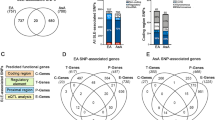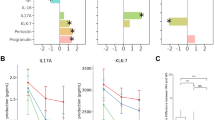Abstract
Although cyclosporine comprises a well-established systemic therapy for psoriasis, patients show important heterogeneity in their treatment response. The aim of our study was the pharmacogenetic analysis of 200 Greek patients with psoriasis based on the cyclosporine pathway related protein-protein interaction (PPI) network, reconstructed through the PICKLE meta-database. We genotyped 27 single nucleotide polymorphisms, mapped to 22 key protein nodes of the cyclosporine pathway, via the utilization of the iPLEX®GOLD panel of the MassARRAY® System. Single-SNP analyses showed statistically significant associations between CALM1 rs12885713 (P = 0.0108) and MALT1 rs2874116 (P = 0.0006) polymorphisms with positive response to cyclosporine therapy after correction for multiple comparisons, with the haplotype analyses further enhancing the predictive value of rs12885713 as a pharmacogenetic biomarker for cyclosporine therapy (P = 0.0173). Our findings have the potential to improve our prediction of cyclosporine efficacy and safety in psoriasis patients, as well as provide the framework for the pharmacogenetics of biological therapies in complex diseases.
This is a preview of subscription content, access via your institution
Access options
Subscribe to this journal
Receive 6 print issues and online access
$259.00 per year
only $43.17 per issue
Buy this article
- Purchase on Springer Link
- Instant access to full article PDF
Prices may be subject to local taxes which are calculated during checkout

Similar content being viewed by others
Data availability
Data are available upon request from the corresponding author.
References
Parisi R, Symmons DPM, Griffiths CEM, Ashcroft DM. Global epidemiology of psoriasis: A systematic review of incidence and prevalence. J Investigative Dermatol. 2013;133:377–85.
Rigopoulos D, Gregoriou S, Katrinaki A, Korfitis C, Larios G, Stamou C, et al. Characteristics of psoriasis in Greece: An epidemiological study of a population in a sunny Mediterranean climate. Eur J Dermatol. 2010;20:189–95.
Mylonas A, Conrad C. Psoriasis: Classical vs. Paradoxical. The Yin-Yang of TNF and type I Interferon. Front Immunol. 2018;9:2746.
Grän F, Kerstan A, Serfling E, Goebeler M, Muhammad K. Current developments in the immunology of psoriasis. Yale J Biol Med. 2020;93:97–110.
Colombo MD, Cassano N, Bellia G, Vena GA. Cyclosporine regimens in plaque psoriasis: An overview with special emphasis on dose, duration, and old and new treatment approaches. Sci World J. 2013;2013:1–11.
Matsuda S, Koyasu S. Mechanisms of action of cyclosporine. Immunopharmacology. 2000;47:119–25.
Singh, K & Argáez, C. Cyclosporine for Moderate to Severe Plaque Psoriasis in Adults: A Review of Clinical Effectiveness and Safety. (Canadian Agency for Drugs and Technologies in Health, 2018).
Ovejero-Benito MC, Muñoz-Aceituno E, Reolid A, Saiz-Rodríguez M, Abad-Santos F, Daudén E. Pharmacogenetics and pharmacogenomics in moderate-to-severe psoriasis. Am J Clin Dermatol. 2018;19:209–22.
Dimitrakopoulos GN, Klapa MI, Moschonas NK. PICKLE 3.0: Enriching the human meta-database with the mouse protein interactome extended via mouse–human orthology. Bioinformatics. 2021;37:145–6.
Dimitrakopoulos GN, Klapa MI, Moschonas NK. How far are we from the completion of the human protein interactome reconstruction? Biomolecules 2022;12:140.
Shannon P, Markiel A, Ozier O, Baliga NS, Wang JT, Ramage D, et al. Cytoscape: A software environment for integrated models of biomolecular interaction networks. Genome Res. 2003;13:2498–504.
Vasilopoulos Y, Sarri C, Zafiriou E, Patsatsi A, Stamatis C, Ntoumou E, et al. A pharmacogenetic study of ABCB1 polymorphisms and cyclosporine treatment response in patients with psoriasis in the Greek population. Pharmacogenomics J. 2014;14:523–5.
Gabriel S, Ziaugra L & Tabbaa D. SNP Genotyping using the sequenom MassARRAY iPLEX platform. Curr Protocols Human Genet. 2009;60 (Chapter 2: Unit 2.12).
Lin DY, Hu Y, Huang BE. Simple and efficient analysis of disease association with missing genotype data. Am J Hum Genet. 2008;82:444–52.
Liu T, Zhang L, Joo D, Sun S-C. NF-κB signaling in inflammation. Sig Transduct Target Ther. 2017;2:17023.
Rezzani R. Cyclosporine A and adverse effects on organs: histochemical studies. Prog Histochemistry Cytochemistry. 2004;39:85–128.
Li S-J, Wang J, Ma L, Lu C, Wang J, Wu J-W, et al. Cooperative autoinhibition and multi-level activation mechanisms of calcineurin. Cell Res. 2016;26:336–49.
Cruchaga C, Kauwe JSK, Mayo K, Spiegel N, Bertelsen S, Nowotny P, et al. SNPs associated with cerebrospinal fluid phospho-tau levels influence rate of decline in Alzheimer’s Disease. PLoS Genet. 2010;6:e1001101.
Karch CM, Jeng AT, Goate AM. Calcium phosphatase calcineurin influences tau metabolism. Neurobiol Aging. 2013;34:374–86.
Jensen HH, Brohus M, Nyegaard M, Overgaard MT. Human Calmodulin Mutations. Front Mol Neurosci 2018;11:396.
Toutenhoofd SL, Foletti D, Wicki R, Rhyner A, Garcia F, ToIon R, et al. Of the human CALM2 calmodulin gene and comparison of the transcriptional activity of CALIVlly CALM2 and CALM3. Cell Calcium 1998;16:323–38.
Shi J, Gao S, Lv Z, Sheng W, Kang H. The association between rs12885713 polymorphism in CALM1 and risk of osteoarthritis: A meta-analysis of case–control studies. Medicine. 2018;97:e12235.
Bryzgalov LO, Antontseva EV, Matveeva MY, Shilov AG, Kashina EV, Mordvinov VA, et al. Detection of Regulatory SNPs in Human Genome Using ChIP-seq ENCODE Data. PLoS ONE. 2013;8:e78833.
Rebeaud F, Hailfinger S, Posevitz-Fejfar A, Tapernoux M, Moser R, Rueda D, et al. The proteolytic activity of the paracaspase MALT1 is key in T cell activation. Nat Immunol. 2008;9:272–81.
Turki A, Mahjoub T, Mtiraoui N, Abdelhedi M, Frih A, Almawi WY. Association of POL1, MALT1, MC4R, PHLPP and DSEL single nucleotide polymorphisms in chromosome 18q region with type 2 diabetes in Tunisians. Gene. 2013;527:243–7.
McDonough CW, Bostrom MA, Lu L, Hicks PJ, Langefeld CD, Divers J, et al. Genetic analysis of diabetic nephropathy on chromosome 18 in African Americans: linkage analysis and dense SNP mapping. Hum Genet. 2009;126:805–17.
Gooch JL, King C, Francis CE, Garcia PS, Bai Y. Cyclosporine A alters expression of renal microRNAs: New insights into calcineurin inhibitor nephrotoxicity. PLoS ONE. 2017;12:e0175242.
Qiu J, Chen Y, Huang G, Zhang Z, Chen L, Na N. Transforming growth factor-β activated long non-coding RNA ATB plays an important role in acute rejection of renal allografts and may impacts the postoperative pharmaceutical immunosuppression therapy: lncRNA-ATB in renal allografts. Nephrology. 2017;22:796–803.
Acknowledgements
This work was partially funded by the MSc “Toxicology” program, University of Thessaly. This work was also supported by the project “Infrastructure for preclinical and early-phase clinical development of drugs, therapeutics and biomedical devices (EATRIS-GR)” (MIS 5028091: EATRIS-GR-UPatras, co-PI: NKM) which is implemented under the Action “Reinforcement of the Research and Innovation Infrastructure”, funded by the Operational Programme “Competitiveness, Entrepreneurship and Innovation” (NSRF 2014-2020) and cofinanced by Greece and the European Union (European Regional Development Fund).
Author information
Authors and Affiliations
Contributions
Participated in research design: YV and NKM; Sample isolation: AK, EZ, AK, AR-S, DS, SG, KG; Conducted experiments: CA, EFS, AL, DD; Performed data analysis: CA, EE; Write or contributed to the manuscript preparation: CA, AP, EZ, EFS, AL, AK, EE, DD, AR-S, DS, SG, KG, NKM, YV. All authors agree with the submission of this manuscript and agree to be accountable for all aspects of this study.
Corresponding author
Ethics declarations
Competing interests
The authors declare no competing interests.
Additional information
Publisher’s note Springer Nature remains neutral with regard to jurisdictional claims in published maps and institutional affiliations.
Supplementary information
Rights and permissions
Springer Nature or its licensor holds exclusive rights to this article under a publishing agreement with the author(s) or other rightsholder(s); author self-archiving of the accepted manuscript version of this article is solely governed by the terms of such publishing agreement and applicable law.
About this article
Cite this article
Antonatos, C., Patsatsi, A., Zafiriou, E. et al. Protein network and pathway analysis in a pharmacogenetic study of cyclosporine treatment response in Greek patients with psoriasis. Pharmacogenomics J 23, 8–13 (2023). https://doi.org/10.1038/s41397-022-00291-7
Received:
Revised:
Accepted:
Published:
Issue Date:
DOI: https://doi.org/10.1038/s41397-022-00291-7



